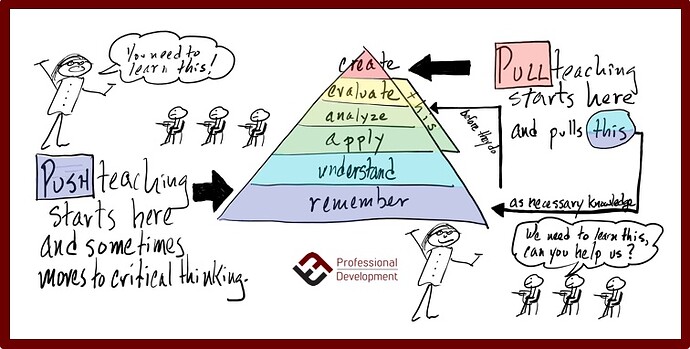An interesting article popped into my inbox yesterday, that I think makes a good analogy for guiding students in project based learning. It asks the question, simply, are you pushing or pulling your learners? In the ‘push’ model, the teacher has a destination or concept they are actively pushing towards (the article likens it to factories pumping out a high volume of products that are then pushed on to consumers). In the ‘pull’ modality, the guiding question of the concept is asked of students, then the teacher pulls the knowledge, questions, etc. from students to reach the destination. Like this illustration:
When ‘pulling’ students, presumably their motivation to learn is stronger, as is the image of themselves as capable, confident problem solvers. This quote in particular resonated with me:
When we engage in teaching and learning using a “pull” dynamic we’re effectively helping students process the types of complex problems and ideas in ways they are likely to need to be able to do. This doesn’t mean content learning or knowledge isn’t important, far from it. But just knowing things won’t be good enough for the future. Being able to analyze, synthesize, evaluate…think critically and ask beautiful questions with and about that knowledge is what we need to focus on.
I thought this could be good food for thought… so please share your thoughts here!
Good questions. My only fear with the pull model, as described in that image, is that teachers and students both need to have a clear understanding of the goal.
I can ask questions of students, but what happens when their approach/answer/goal is totally different than what I am expecting? This gets into (I think) a more fundamental question that the article doesn’t address - what are we doing this for?
Way back when I was getting interviewed for my teaching job, I did a whole presentation on turning Bloom’s taxonomy upside down, exactly what they are talking about in this article. Not saying that to show how progressive I was, because when I applied that to my classroom I failed miserably. I realize know that the failure was because I still had a specific goal for the lesson in mind. I was just going about it a different way - instead of foregrounding the knowledge via direct instruction, I was foregrounding the questions I wanted the students to explore.
Some students took the questions into entirely different directions. Many never moved beyond surface knowledge. Some were uninterested. At the end of the day, I was still making the lesson and the assessment about me and not about us.
In summary, I think the only the that a teacher can work with a framework described in that article is to first make assessment something that is done with the students, not to them. So when you ask the question, what am I doing this for, you are actually asking that question together with your students. I think that unlocks the type of engagement that the article is speaking of - but you must start with that first, not with the the inversion of Bloom’s taxonomy.
2 Likes
I agree. I think that this is a step in the right direction in terms of learning partnerships between students and teachers, and that a step further is needed to make it truly authentic. There is definitely a degree of ‘letting go’ (cue the Elsa music here) that is needed in order to work in this way - even to just take the first steps like those this article proposes, and that can be a very difficult place to be for teachers.
Much of teaching is performative, and teachers (for better or worse, fairly or unfairly) are judged for their performance. So taking that leap to teach in a more student-centered way can be scary if you think you’ll be judged harshly for trying something new and failing. However, there is hope to be found in having the confidence and trust in yourself and your students to be able to learn together this way. Instead of needing to have the supreme confidence to have all the answers, you can have confidence and trust in your AND YOUR STUDENTS’ abilities to find them together. @Aimee_DeFoe and I have been talking about this a bit lately, and how building a trusting classroom community is so important to authentic teacher-student partnerships. (This is probably a digression from the original post but one that I think is important)

